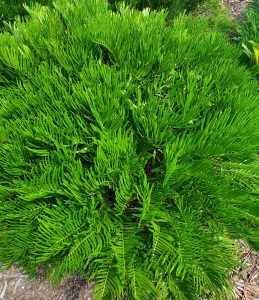
The coontie is one of the most appreciated and acceptable native plants for landscaping in our area. Every garden center has some in stock and the coontie’ s unique beauty is its selling point. The horticultural qualities as a Florida-Friendly Landscaping™ approved plant and its historical significance make the coontie worth promoting and owning.
Horticulturally, the coontie is our own native cycad related to other familiar plants such as the Cardboard Plant and Sago “palms”. Cycads have palm-like fronds and cone-like flower structures. Found from southeast Georgia south through Florida with relatives down on into the West Indies, the coontie prefers pinelands and well-drained soils. Unfortunately, past over-collection in the wild due to its former use as a starch source and for landscape subjects, have made the coontie scarce in the wild. In fact, the coontie is on the Florida Commercially Exploited Plant list and it is illegal to collect them from the wild. Propagated from seeds, nursery cultivated plants are readily available and make splendid landscape plants.
The coontie is a great, hardy Florida-Friendly Landscaping™ native plant because it is highly drought tolerant and requires little maintenance in the landscape once established. This plant is best described as looking like a fern or small palm with feathery deep green, glossy fronds up to three feet long. The plants are either male or female and accordingly produce different unique flowering structures. The male plants develop a thin, cone-like “flower” up to seven inches long which produces pollen. Female plants produce more robust cones that are about six inches tall and velvety, brown, and scaly. These mature female cones eventually fall apart revealing bright orange-red seeds.
The coontie is very adaptable to site conditions ranging from full sun to deep shade. This cycad also has moderate to high salt tolerance and adapts well to coastal areas. You can fit a coontie into your landscape as a single specimen or as a mass groundcover. For a low maintenance ground cover, space the plants up to twenty inches apart in an area that will not be walked upon.
Coupled with its popularity as a garden subject, the coontie has an interesting history. In the past, Native Americans used the root as a starch source. As all parts of the coontie are toxic, processing was needed to make the final product safe to eat. After extensive treatment to remove the toxic chemical contained in the coontie, the finished root flour was made into bread. In the early 1900’s settlers also processed the coontie for the starch using the same techniques for removing the toxic compound. Coontie starch was quite an industry in the Miami area where so-called “Florida Arrowroot“ was produced. Additionally, the long-lasting exotic coontie foliage has been commercially used as filler in floral arrangements.
One additional feature to note is the coontie’ s association with the rare Atala butterfly. The coontie is a food source for the larvae of Atala butterflies. While these hungry caterpillars can defoliate coontie foliage from time to time, the Atala is more often encountered further south. Echo moth caterpillar damage is more likely experienced in our area.
Commercially cultivated coonties are available at all garden centers in our area and through regional native plant nurseries. Planting these native cycads will add an attractive sustainable plant into your landscape, and an interesting conversation starter to share with guests! For more information on all types of native plants, or to ask a question, you can also call the Master Gardener Volunteer Helpdesk on Mondays, Wednesdays, and Fridays from 1 to 4 pm at 764-4340 for gardening help and insight into their role as an Extension volunteer. Ralph E. Mitchell is the Director/Horticulture Agent for UF/IFAS Extension – Charlotte County. He can be reached at 941-764-4344 or ralph.mitchell@charlottecountyfl.gov, Connect with us on social media. Like us on Facebook @CharlotteCountyExtension and follow us on Instagram @ifascharco.
Resources:
Lamborn, A. R. (2016) Coontie – Zamia pumila (Z. floridana). The University of Florida Extension Services, IFAS – Baker County.
UF/IFAS Gardening Solutions – Coontie. The University of Florida Extension Services, IFAS.
Stevenson (2021) The Coontie : Butterflies, Florida Friendly Landscaping, Native plants. The University of Florida Extension Services, IFAS – Escambia County.
Koi, S. &Hall, D. W. (2022) Atala Butterfly, Atala Hairstreak, Coontie Hairstreak, Eumaeus atala Poey 1832 (Insecta: Lepidoptera: Lycaenidae) The University of Florida Extension Services, IFAS.
The Florida-Friendly Landscaping™ Guide to Plant Selection & Landscape Design (2022) The University of Florida Extension Services, IFAS.
Echo moth caterpillar (2020) UF Entomology & Nematology Department, UF/IFAS Facebook Page.
FLORIDA 4-H FOREST ECOLOGY (2023) COONTIE. The University of Florida Extension Services, IFAS.
Silvasy, T. (2023) Top Native Plants for Central Florida. The University of Florida Extension Services, IFAS – Orange County.
Sedore D. (2023) Wild South Florida Atala Butterfly. https://wildsouthflorida.com/atala.butterfly.html
 1
1
